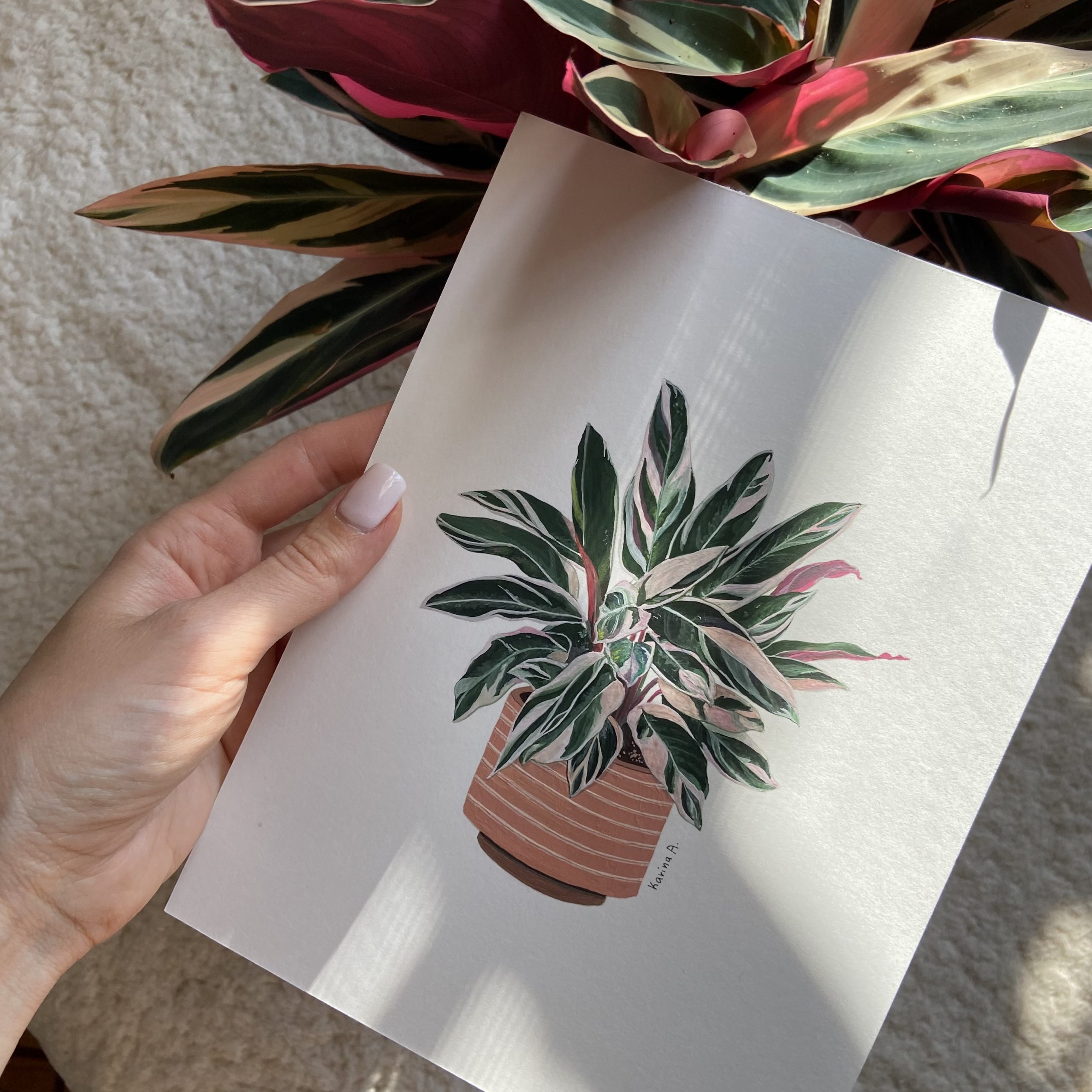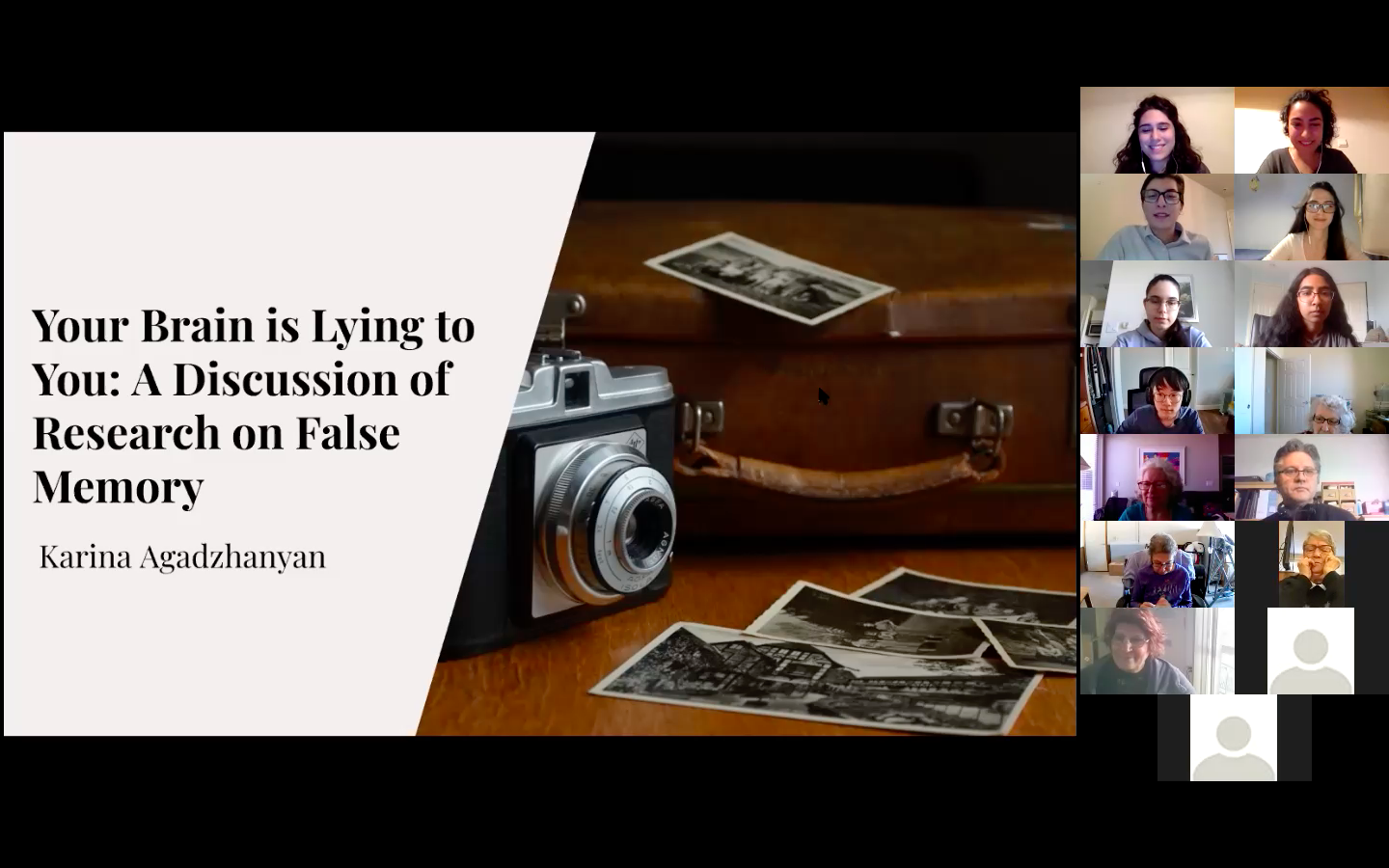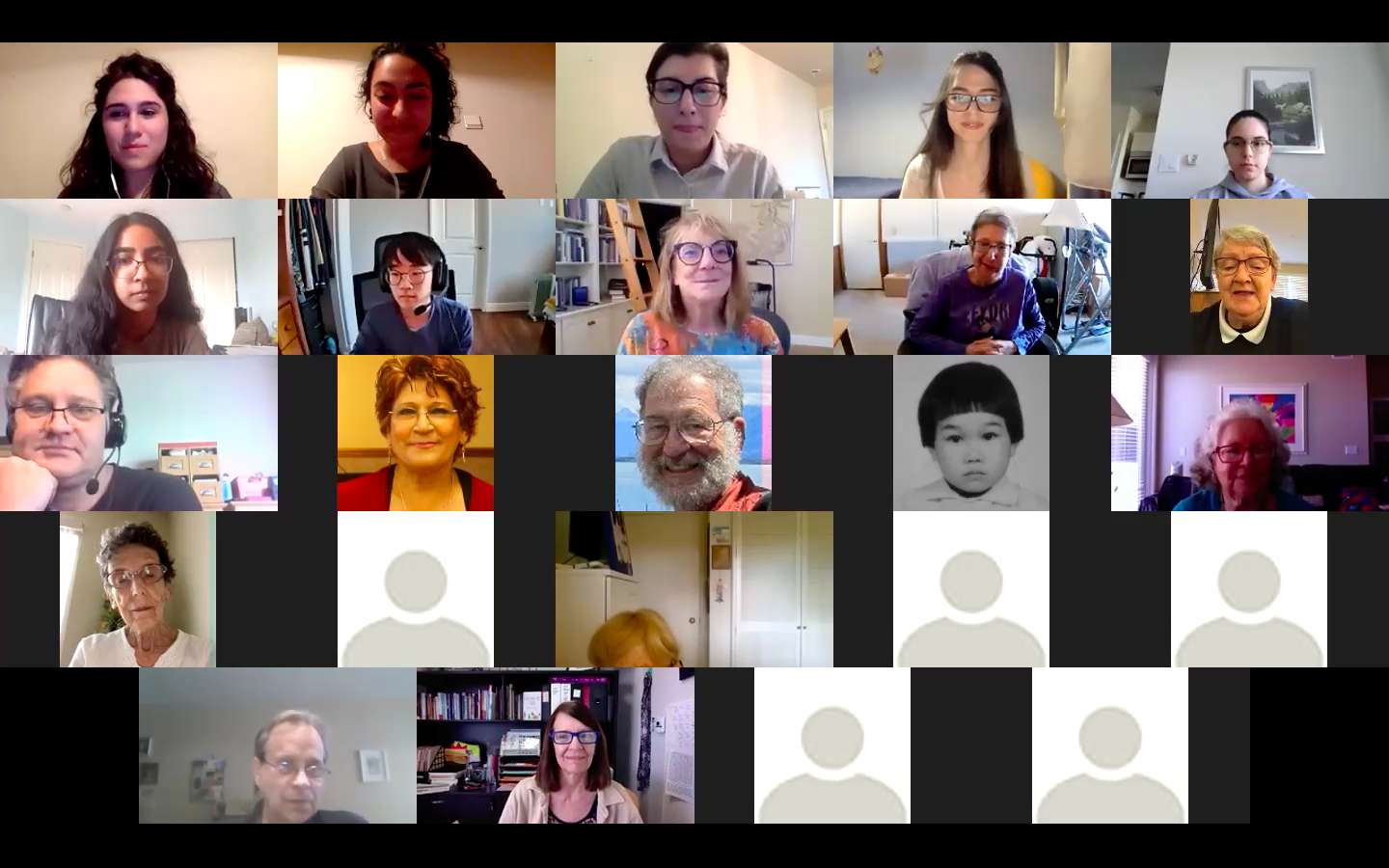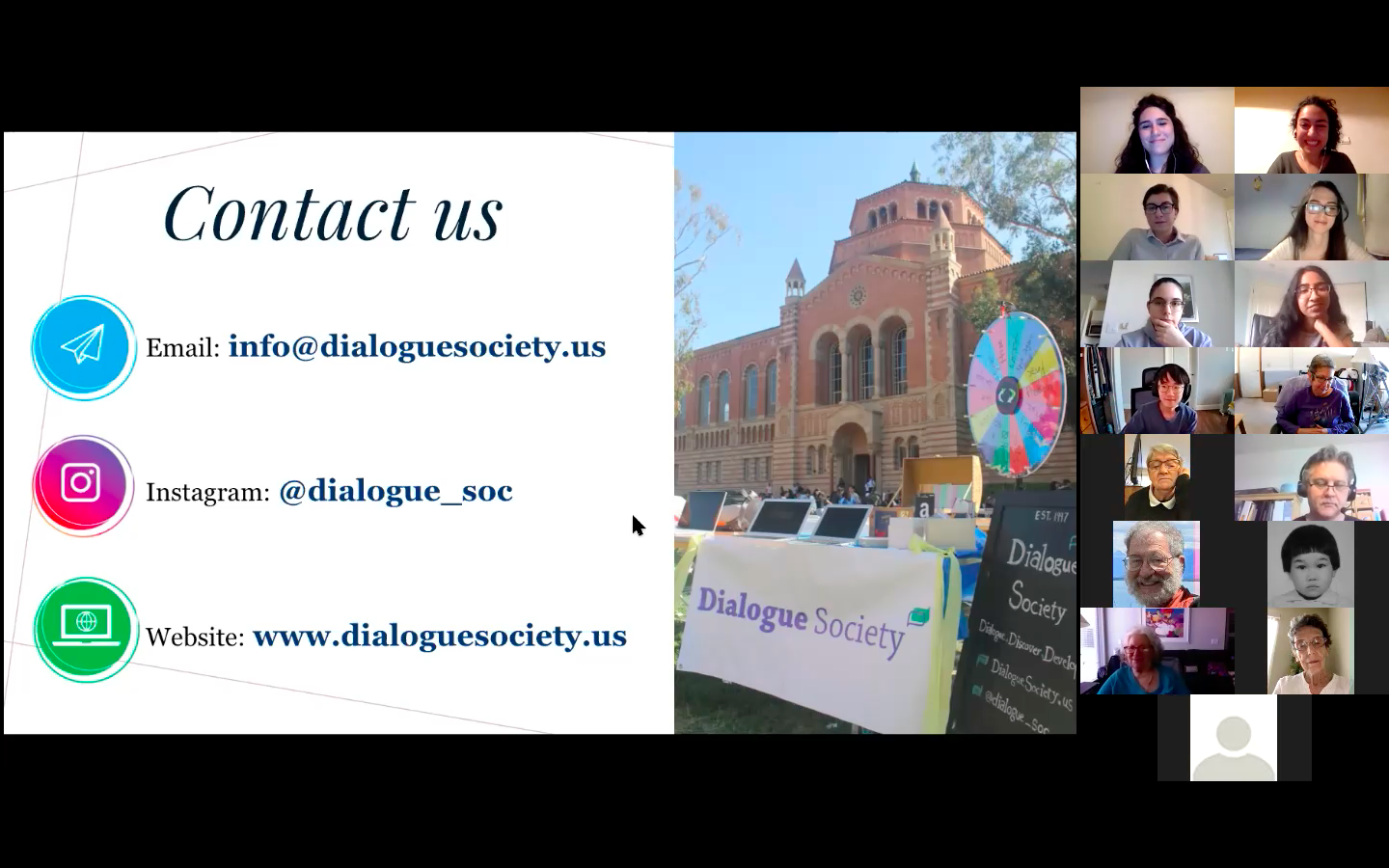By Karina Agadzhanyan and Dina Doustmohammadi – UCLA chapter members
In the past year, Dialogue Society’s UCLA chapter has been holding a series of workshops covering various topics in the field of cognitive psychology, such as successful aging and ways to keep memory functioning intact. For this blog, we sat down with one of our UCLA alumna and student members to chat more about a workshop she held on false memory.
Hi Karina, tell us a little about yourself.
My name is Karina Agadzhanyan, and I am a UCLA alumna (20’) and an incoming Ph.D. student in cognitive psychology studying memory and attention. In my free time, I enjoy exploring the world around me in search of inspiration. I am entirely positive that engaging in creative activities can help to improve not only our mental but also physical health, and that is why keeping up with hobbies is so important. As a long-time house plant enthusiast, it was only a matter of time for me to buy the right paints and brushes and start creating plant art. I chose painting because it allows me to stimulate my brain in ways that are contrary to my normal routine as an academic researcher.
With time I came to an understanding that starting a new painting is very similar to starting a new research project as my brain learned to incorporate both types of activities.
Here’s how it happens. I begin with searching for a theoretical basis or references for the artwork (aka literature review), then proceed to making a sketch with pencil and eraser (pilot data) as well as predicting the right color combinations (variables of interest/hypotheses). Once the sketch and color palette are done, I proceed to adding layers (step-by-step procedure). It takes a few hours, sometimes days to reach the perfect results, but it is always worth the time and effort when the final result exceeds your expectations and finds its purpose.
It brings me so much joy to transform a blank piece of paper into a painting, not to mention the cognitive benefits of painting. Engaging in art may promote deep processing of information which allows for better memory performance (Craik & Lockhart, 1974; Medved et al., 2004) much needed in education and in the workplace. And most importantly, engaging in art improves memory, attention and learning through conceptual visualization and implementation (Posner & Patoine, 2009; Rosier et al., 2013).


When did you join the Dialogue Society at UCLA and what made you decide to join?
I have been a member of Dialogue Society since September 2020. When I first joined the organization, I had absolutely no idea what to expect and how things would work out for me eventually. I was extremely excited to become part of the team to help promote physical, mental, and social wellness. When I filled out my application, lots of potential ideas would pop into my mind and that is when I realized that Dialogue Society would be a perfect fit for me.
How has your experience been in the Senior Outreach Program so far?
I joined Dialogue Society slightly after I graduated with my B.A. in psychology. During my college time, I did not feel the need to join any student organizations and chose to mainly focus on gaining research experience. While it is important to manage our time wisely and listen to our specific needs, engaging with and giving back to the community was something I overlooked and omitted from my college experience. Joining Dialogue Society’s Senior Outreach Program allowed me to fulfill a portion of my life that was missing. For the past year and a half, I have enjoyed working with the board and other volunteers while we continued to hold remote events for the seniors. It goes so much into each of our events and I am happy to be part of the process!
You have been incredibly active with the organization with multiple projects and workshops under your belt. For your false memory workshop, what was the inspiration behind that topic?
During Winter 2020, I was given the opportunity to lead an informational workshop on a topic of my choice. It did not take me long to choose to present on false memories. Memory malfunctions have always been a field in memory research I was truly curious about as it has many real-world applications. Learning that our memory is not working like a video camera is crucial as it makes us cautious when it comes to situations like misremembering details of shocking public events or even some more extreme instances, like experiencing illusory recollections of entire childhood events. Therefore, I was eager to share the existing knowledge in the field of false memories with our senior members and participants.
How did you prepare for your workshop? What were the factors you took into consideration?
To prepare for the workshop, I referenced a blog post article I wrote together with another PhD student. The blog was written for UCLA’s Psychology in Action, a scientific communication organization run by psychology graduate students, and could be accessed through this link. Together with the board, we worked on breaking down scientific experiments into stories that could easily be comprehended by the general public. As much as it is crucial to publish scientific results, presenting and sharing important discoveries is no less important. Therefore, I focused on making the presentation both engaging and accessible.
What was the highlight of the session for you?
When the workshop started, we were happy to welcome all of our senior members as well as a few surprising guests. When preparing for the workshop, none of us expected to see Dr. Elizabeth Loftus, a well-known researcher and an expert in the field of false memories, in the list of participants. Astonished and pleasantly shocked, we started the workshop. No words can describe how happy I was to be presenting on Elizabeth Loftus’s research, whose work I truly admire, and have her in the audience. All my feelings immediately showed on my face and it was hard to control my excitement throughout the presentation. It was a true miracle; as if all the stars aligned for me.
After the presentation, during the Q&A segment, I received great feedback from Dr. Loftus and together, we answered the audience’s questions. I could not believe I was talking with someone whom I only knew through scientific studies we learned in our psychology classes.
Thanks to this workshop, I was able to join Elizabeth Loftus’s Lab at the University of California, Irvine. Moreover, not too long ago, I had an amazing opportunity to meet her in person and gift her one of my paintings. I am endlessly grateful for how things turned out for me. It is truly a one-off event and I am so thankful to have experienced it.
Lastly, what advice would you give to volunteers who are and will be preparing workshops in the Senior Outreach Program?
One of my favorite quotes I live by states, “Nothing is as important as passion. No matter what you want to do with your life, be passionate.” (Jon Bon Jovi) I believe that great things happen when we set the right intentions and follow them every step of the way.
Here are a few useful tips:
Start with something that is both useful for seniors and is truly interesting to you. It’s not hard to notice whether a person is excited or not about the topic he or she is presenting on.
Start the thinking process early. Create an imaginary outline in your mind and develop it day by day; highlight things you want to include in your presentation. This way you won’t feel overwhelmed when you start working on the PowerPoint.
Have a rough draft ready at least two weeks before the presentation day and have other people look at it or even present to them to practice. This will provide you with enough time to incorporate other people’s feedback. It will also help you see the presentation as a whole and better organize it in your head which will help you feel more confident during the presentation. Lastly, it will allow you to absorb the material and create a coherent story out of it which will transfer into how well your listeners will comprehend and remember the material.
Try to include a few interactive slides in your presentation. Our attention span isn’t the best and it’s always good to give our brains a little bit of rest before moving on to the next subtopic. Moreover, learning information in an interactive way improves encoding (deep processing) versus learning just from plain text (shallow processing) (Craik & Lockhart, 1974).
One creative way that will help engage your participants would be storytelling, or presenting information in a way that allows for the listeners to make their own interpretations of events and ideas. Research has shown that storytelling is an effective way to engage students in the class in a way that it can evoke emotional engagement (Eades, 2006).
Last but not least, remember the purpose of the workshop and try to engage your audience by making the information relevant and important. Make sure to ask the right questions and allow for a good amount of time for discussion. Such discussions result in both the presenters and the seniors learning from each other, and that is probably one of the main goals we aim for.
Thank you Karina for sitting down with us today!
Our workshops are a staple of our program. We are always creating and offering new and exciting informative sessions covering a variety of topics each quarter. For our readers out there, all of our virtual events are completely free of charge and open to all. If you or your organization are interested in joining any of our sessions, please visit our website, subscribe to our mailing list, or follow us on our social media pages to be notified of new events. If you are interested in volunteering with our program, please contact us via email or apply through our website.
Thank you to our amazing team at Dialogue Society at UCLA for their great work! We look forward to hosting more workshops in the coming quarters!
References
Craik, F. I. M., & Lockhart, R. S. (1972). Levels of processing: A framework for memory research. Journal of Verbal Learning and Verbal behavior, 11, 671-684.
Eades, J. M. (2006). Classroom tales using storytelling to build emotional, social and academic skills across the primary curriculum. London. Jessica Kingsley Publishers.
Medved, M.I., Cupchik, G.C., & Oatley, K. (2004). Interpretative memories of artworks. Memory, 12, 119-128.
Posner, M., & Patoine, B. (2009). How arts training improves attention and cognition. Cerebrum. Retrieved August 22, 2021 from http://www.dana.org/Cerebrum/2009/How_Arts_ Training_Improves_Attention_and_Cognition/
Rosier, J., Locker, L., & Naufel, K. (2013). Art and Memory: An examination of the learning benefits of visual-arts exposure. North American Journal of Psychology, 15(2), 265- 278.






